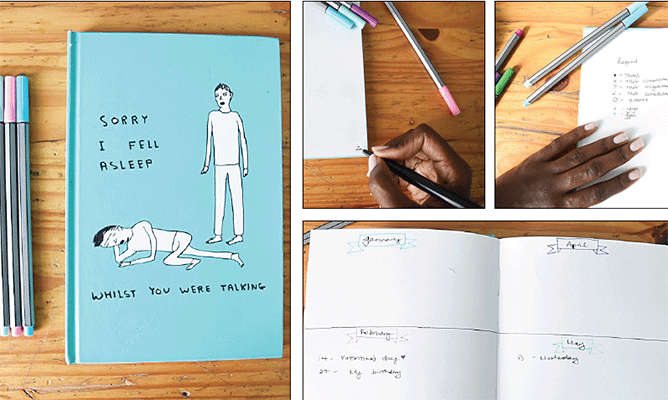We are three weeks into 2018 and your to-do list has probably already started piling up.
From managing a list of all your New Year’s resolutions, appointments, groceries that you need to buy and all the various to-dos, our days and lives can become an overwhelming number of tasks that we sometimes lose track of.
You may have tried Post Its, reminders on your phone, diaries or just random lists scribbled on paper, yet you are still always a little bit behind schedule or you often seem to overlook a thing or two.
When one thinks of journaling, you think of pouring your heart out onto blank pages. It can be a way to track your emotions or memories, document your travels and jot down the places you would love to go to or the goals you would like to achieve. Journaling can be cathartic. A way to self soothe. A creative form of therapy by being reflective.
Bullet journaling takes the therapeutic aspects of journaling to a whole new level. You not only can create journal entries about your head space, but you can also use it as a tool to organise your life, track your habits and create a list of your goals and how to tackle them.
If you like being organised, love to doodle, love stationery and trying new things, bullet journaling is for you – it functions as a journal, a planner and a place to put your to-do-lists, all in one.
While I am sure writing, journaling and doodling have been part of humanity since the beginning of time, the original bullet journal or BuJo was started by Ryder Carroll, a digital product designer based in New York.
Carroll describes a bullet journal as an analogue system he devised to help track the past, organise the present and plan for the future.
Bullet journals are supposed to make your life easier, they aren’t meant to become a chore, eat up too much of your time or become another thing on your to-do list that you never actually get around to doing.
First things first, you will need a blank notebook that is roughly an A5 size, anything smaller might be difficult to write in, and anything too big could become a hassle to carry around with you all the time. A dotted grid notebook might work better, or one with no lines.
Bullet journaling can seem a bit intimidating when you Google all the jargon that comes along with it. These are a few of the most used terms:
Just another way to say table of contents. By numbering your pages and keeping an index, it allows you to stay on track with where everything is in your journal.
Functioning like a yearly calendar, this is where you break down all the big events or tasks that you need to do in the year ahead, like get your mom a gift on Mother’s Day in May or how many kilos you want to lose by December.
This functions like a monthly calendar where you list all the things you need to accomplish during the month. It is usually made up of two parts, one being the dates in the month and the opposite page being the tasks that you need to complete that month.
This is where you write down all the things you have accomplished that day as well as your observations. It can include things like how many glasses of water you drank, how much money you spent, steps taken, calories consumed, what you cooked, etc.
To make your bullet journal more efficient, you can use symbols to signify things and write in shorter sentences. It is a way to get more succinct and to the point.
Bullet journals are meant to be a faster way of journaling and finding a quick way to access, read and track your life. A legend helps to make that process easier by adding symbols and using specific colours as signifiers so you know what that means. Like a red dot for priority or a green dot for needs to be done in the next two days.
At the end of each day/week/month, if you see that there are tasks you haven’t completed, you can migrate them to the next day/week/month if they are still important for you to do.
• A pen
• A ruler
• Colourful pens
• Washi tape (optional)
• Number each page of your bullet journal.
Stay informed with The Namibian – your source for credible journalism. Get in-depth reporting and opinions for
only N$85 a month. Invest in journalism, invest in democracy –
Subscribe Now!










